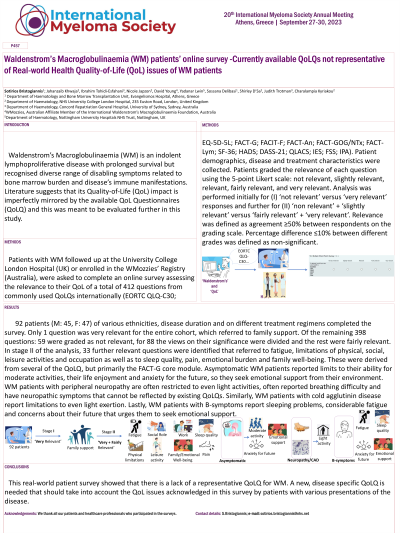QoL and Patient-Reported Outcome and Supportive Care
Poster Session 3
P-457: Waldenstrom’s Macroglobulinaemia (WM) patients’ online survey -Currently available QoLQs not representative of Real-world Health Quality-of-Life (QoL) issues of WM patients
Friday, September 29, 2023
1:15 PM - 2:15 PM EEST


Sotirios Bristogiannis
Haematology Registrar
Evangelismos General Hospital, Athens, Greece
Athens, Attiki, Greece
Introduction: Waldenstrom’s Macroglobulinaemia (WM) is an indolent lymphoproliferative disease with prolonged survival but recognised diverse range of disabling symptoms related to bone marrow burden and disease’s immune manifestations. Literature suggests that its QoL impact is imperfectly mirrored by the available QoL Questionnaires (QoLQ) and this was meant to be evaluated further in this study.
Methods: Patients with WM followed up at the University College London Hospital (UK) or enrolled in the WMozzies’ Registry (Australia), were asked to complete an online survey assessing the relevance to their QoL of a total of 412 questions from commonly used QoLQs internationally (EORTC QLQ-C30; EQ-5D-5L; FACT-G; FACIT-F; FACT-An; FACT-GOG/NTx; FACT-Lym; SF-36; HADS; DASS-21; QLACS; IES; FSS; IPA). Patient demographics, disease and treatment characteristics were collected. Patients graded the relevance of each question using the 5-point Likert scale: not relevant, slightly relevant, relevant, fairly relevant, and very relevant. Analysis was performed initially for (I) ‘not relevant’ versus ‘very relevant’ responses and further for (II) ‘non relevant’ + ‘slightly relevant’ versus ‘fairly relevant’ + ‘very relevant’. Relevance was defined as agreement ≥50% between respondents on the grading scale. Percentage difference ≤10% between different grades was defined as non-significant.
Results: 92 patients (M: 45, F: 47) of various ethnicities, disease duration and on different treatment regimens completed the survey. Only 1 question was very relevant for the entire cohort, which referred to family support. Of the remaining 398 questions: 59 were graded as not relevant, for 88 the views on their significance were divided and the rest were fairly relevant. In stage II of the analysis, 33 further relevant questions were identified that referred to fatigue, limitations of physical, social, leisure activities and occupation as well as to sleep quality, pain, emotional burden and family well-being. These were derived from several of the QoLQ, but primarily the FACT-G core module. Asymptomatic WM patients reported limits to their ability for moderate activities, their life enjoyment and anxiety for the future, so they seek emotional support from their environment. WM patients with peripheral neuropathy are often restricted to even light activities, often reported breathing difficulty and have neuropathic symptoms that cannot be reflected by existing QoLQs. Similarly, WM patients with cold agglutinin disease report limitations to even light exertion. Lastly, WM patients with B-symptoms report sleeping problems, considerable fatigue and concerns about their future that urges them to seek emotional support.
Conclusions: This real-world patient survey showed that there is a lack of a representative QoLQ for WM. A new, disease specific QoLQ is needed that should take into account the QoL issues acknowledged in this survey by patients with various presentations of the disease.
Methods: Patients with WM followed up at the University College London Hospital (UK) or enrolled in the WMozzies’ Registry (Australia), were asked to complete an online survey assessing the relevance to their QoL of a total of 412 questions from commonly used QoLQs internationally (EORTC QLQ-C30; EQ-5D-5L; FACT-G; FACIT-F; FACT-An; FACT-GOG/NTx; FACT-Lym; SF-36; HADS; DASS-21; QLACS; IES; FSS; IPA). Patient demographics, disease and treatment characteristics were collected. Patients graded the relevance of each question using the 5-point Likert scale: not relevant, slightly relevant, relevant, fairly relevant, and very relevant. Analysis was performed initially for (I) ‘not relevant’ versus ‘very relevant’ responses and further for (II) ‘non relevant’ + ‘slightly relevant’ versus ‘fairly relevant’ + ‘very relevant’. Relevance was defined as agreement ≥50% between respondents on the grading scale. Percentage difference ≤10% between different grades was defined as non-significant.
Results: 92 patients (M: 45, F: 47) of various ethnicities, disease duration and on different treatment regimens completed the survey. Only 1 question was very relevant for the entire cohort, which referred to family support. Of the remaining 398 questions: 59 were graded as not relevant, for 88 the views on their significance were divided and the rest were fairly relevant. In stage II of the analysis, 33 further relevant questions were identified that referred to fatigue, limitations of physical, social, leisure activities and occupation as well as to sleep quality, pain, emotional burden and family well-being. These were derived from several of the QoLQ, but primarily the FACT-G core module. Asymptomatic WM patients reported limits to their ability for moderate activities, their life enjoyment and anxiety for the future, so they seek emotional support from their environment. WM patients with peripheral neuropathy are often restricted to even light activities, often reported breathing difficulty and have neuropathic symptoms that cannot be reflected by existing QoLQs. Similarly, WM patients with cold agglutinin disease report limitations to even light exertion. Lastly, WM patients with B-symptoms report sleeping problems, considerable fatigue and concerns about their future that urges them to seek emotional support.
Conclusions: This real-world patient survey showed that there is a lack of a representative QoLQ for WM. A new, disease specific QoLQ is needed that should take into account the QoL issues acknowledged in this survey by patients with various presentations of the disease.
